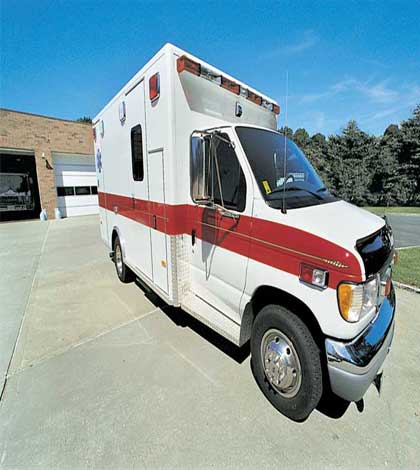MANITOULIN—With the success of the Manitoulin-Sudbury District Services Board’s (DSB) non-urgent patient transportation pilot project in partnership with Manitoulin and Espanola hospitals, the North East Local Health Integration Network (LHIN) has agreed to fund an extension until the end of November.
“We have received funding for a two month extension which will take us to November 30,” Fern Dominelli, DSB CAO, told the Recorder after a DSB board meeting last week. “We are hoping in the meantime that some decisions will be made by the province and LHINs to provide funding on a permanent basis,” he added, noting “with this program, one of the benefits we’ve seen is the emergency medical services work being carried out has now dropped by 50 percent with this program in place.”
In his report to the DSB board last week, Mr. Dominelli explained in a second quarter activity report that the project started March 11. “Over the first four months this project has proven to be both an efficient and effective alternative model of patient transportation.”
Mr. Dominelli told the Recorder that the NE LHIN had provided an additional $30,000 to the pilot project and the Manitoulin Health Centre provided another $10,000 in funding they received from the NE LHIN through its Ontario small hospital funding allotment.
“The question is, who is going to pay for it over the long term?” said Mr. Dominelli. “Right now the NE LHIN is, but there is no ongoing funding after November.” He said it is costing the DSB $56 per hour for the non-urgent patient transfer project, as compared to the estimated cost of $63, “so we are maintaining and actually reducing costs further.”
“At the Association of Municipalities of Ontario annual meeting in August, AMO president Al Spacek said the province provides a 50/50 basis funding for ambulance services in the North, but is paying all the costs in southern Ontario,” said Mr. Dominelli. “But small hospitals in the North don’t have that type of financial flexibility and in the North the EMS is doing the transfers.”
At that same AMO meeting the DSB had a meeting with Minister of Health and Long Term Care Deb Matthews and provided her a briefing on the local project. The briefing notes state, “Established through existing non-profit profit organizations, the service can be operated at a lower cost than that of a private sector that is profit motivated. By our estimates, we were suggesting an hourly ongoing cost of $63.96 whereas the private industry rates range from $100 to upwards of $150 per hour. Additionally, by building on existing infrastructure, services and processes, we have not reinvented the wheel. As each organization already meets rigid quality standards, there will be synergistic benefits of aligning these standards across each sector. This too will further support the work being undertaken to implement the Excellence Care for All Act. Ultimately, all organizations would achieve improved response times/reduced wait times by working together to better coordinator drop-off and pick-ups to achieve better scheduling thus avoiding duplication of service and related multi-trips to and from Sudbury.”
“While the theoretical advantages of the pilot project are abundant, the reality of the project is proving to be even better than anticipated,” reported the DSB. “While the project is still underway, to say that so far it has been anything short of a glowing success would be wrong.”
In looking forward, “our vision for the future of medical transportation in Ontario involves two systems, one for medical emergencies and one for non-urgent/non-ambulance transportation. The highly trained EMS industry in Ontario is effective and necessary to meet the emergency needs of the citizens within the province, but when tasked with providing for non-urgent care, the system fails. It fails not only from a cost perspective but also in terms of effective patients care across the broader patient’s spectrum. The patient sitting at home in rural North Ontario suffering in an emergency does not get as timely care due to the fact that the only ambulance within their community is servicing the needs of a non-urgent patient. The non-urgent patient does not get as timely care because the ambulance is dealing with a medical emergency, which can cause missed appointments and delayed treatment. Finally, the already overwhelmed medical facilities do not receive efficient services as they are at the mercy of the ambulances responding to medical emergencies in the community in many ways. The ambulance cannot be relied upon to arrive on time. Even if it does arrive on time they may be diverted to a medical emergency en route.”
“Lastly, because care is required at another facility, many times the sending facility must send a medical escort to tend to the patients’ needs once at the receiving facility as the ambulance may not be able to say once the patient is delivered,” the DSB noted. “This then causes the real problem of being stranded in a foreign facility for hours or days on end. The patient does not get back to their home bed and the escort will end up working in excess of their normal shift, causing overtime and unbudgeted expenses.”
The DSB notes states, “The non-urgent patient transportation system needs to be considered as a vital part of the health care system in Ontario. Utilizing the emergency ambulance system to perform this necessary process is both ineffective and inefficient. Removing the ambulance system from non-urgent patient transportation is an example of a change required to fall in line with moving forward under the vision of the government of Ontario and more specifically the MOHLTC.”





